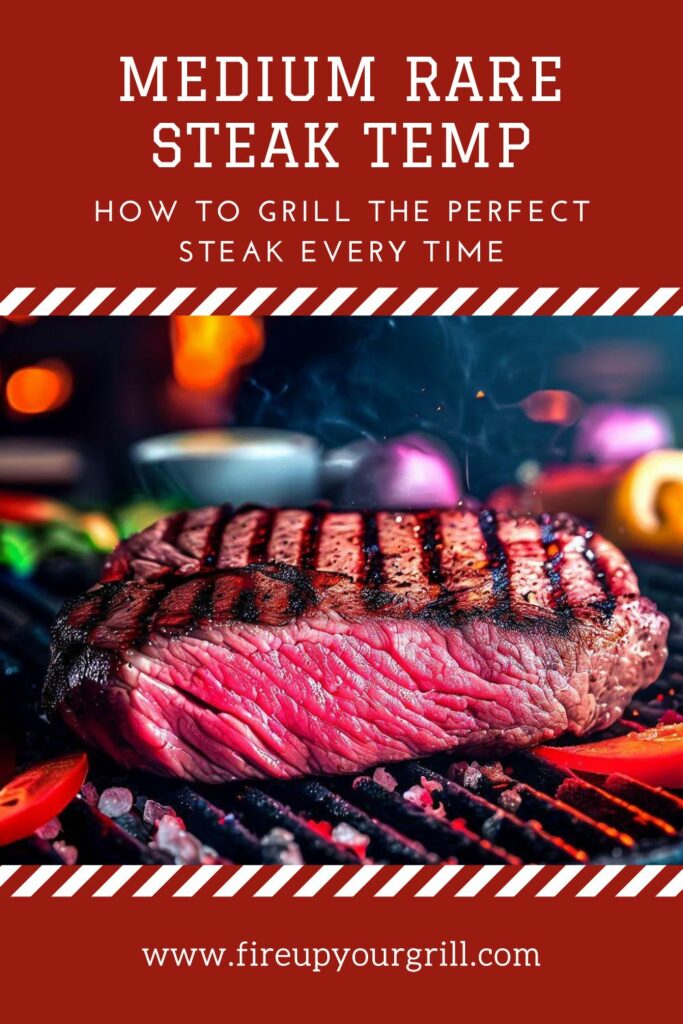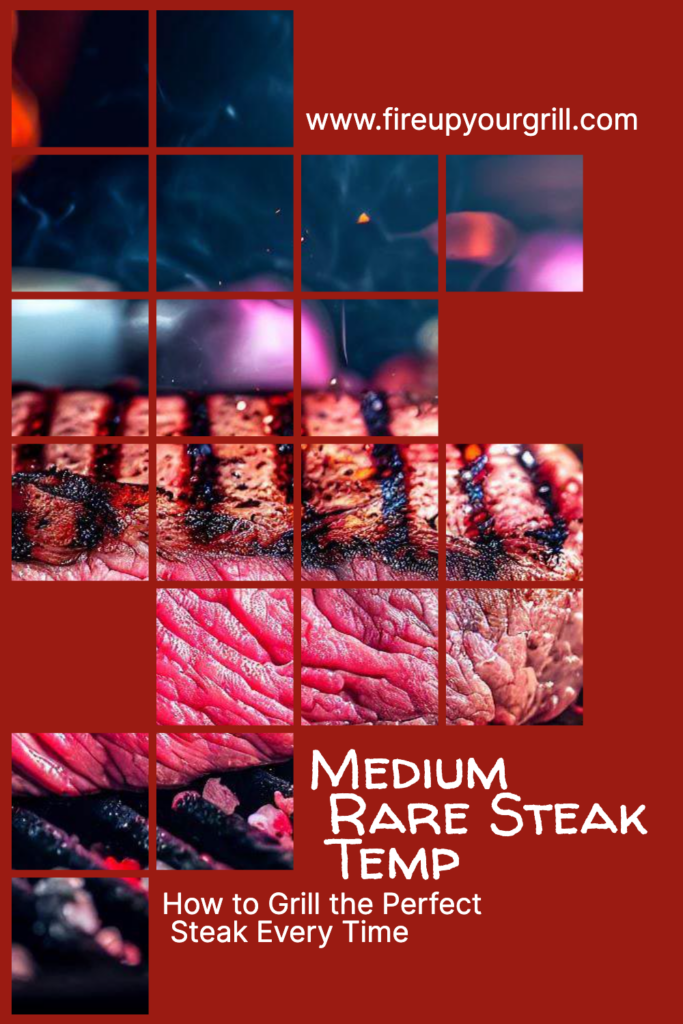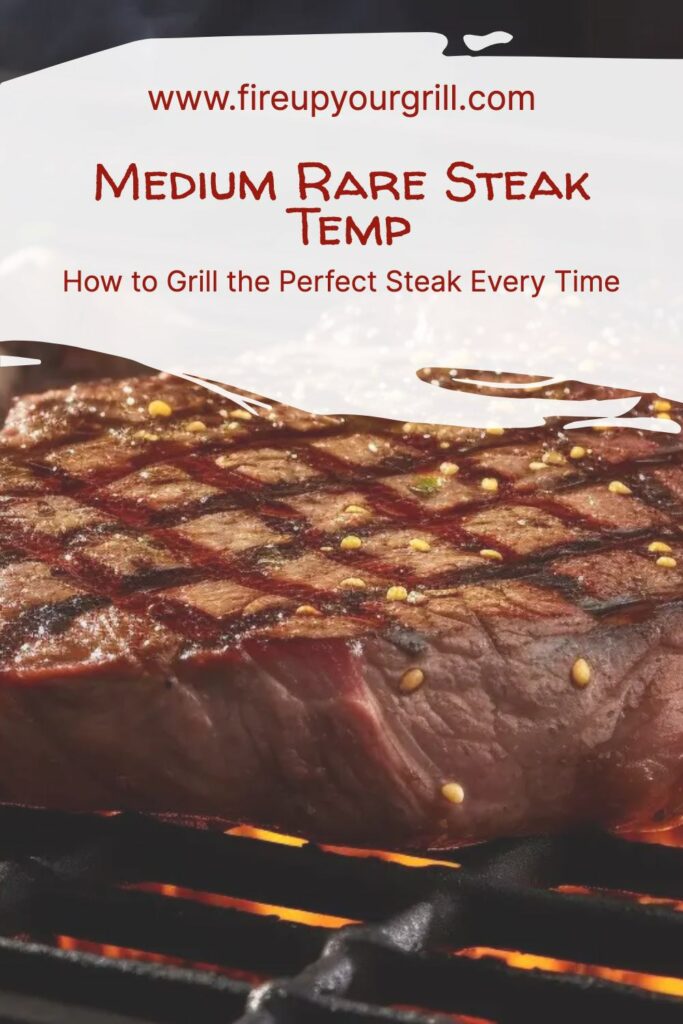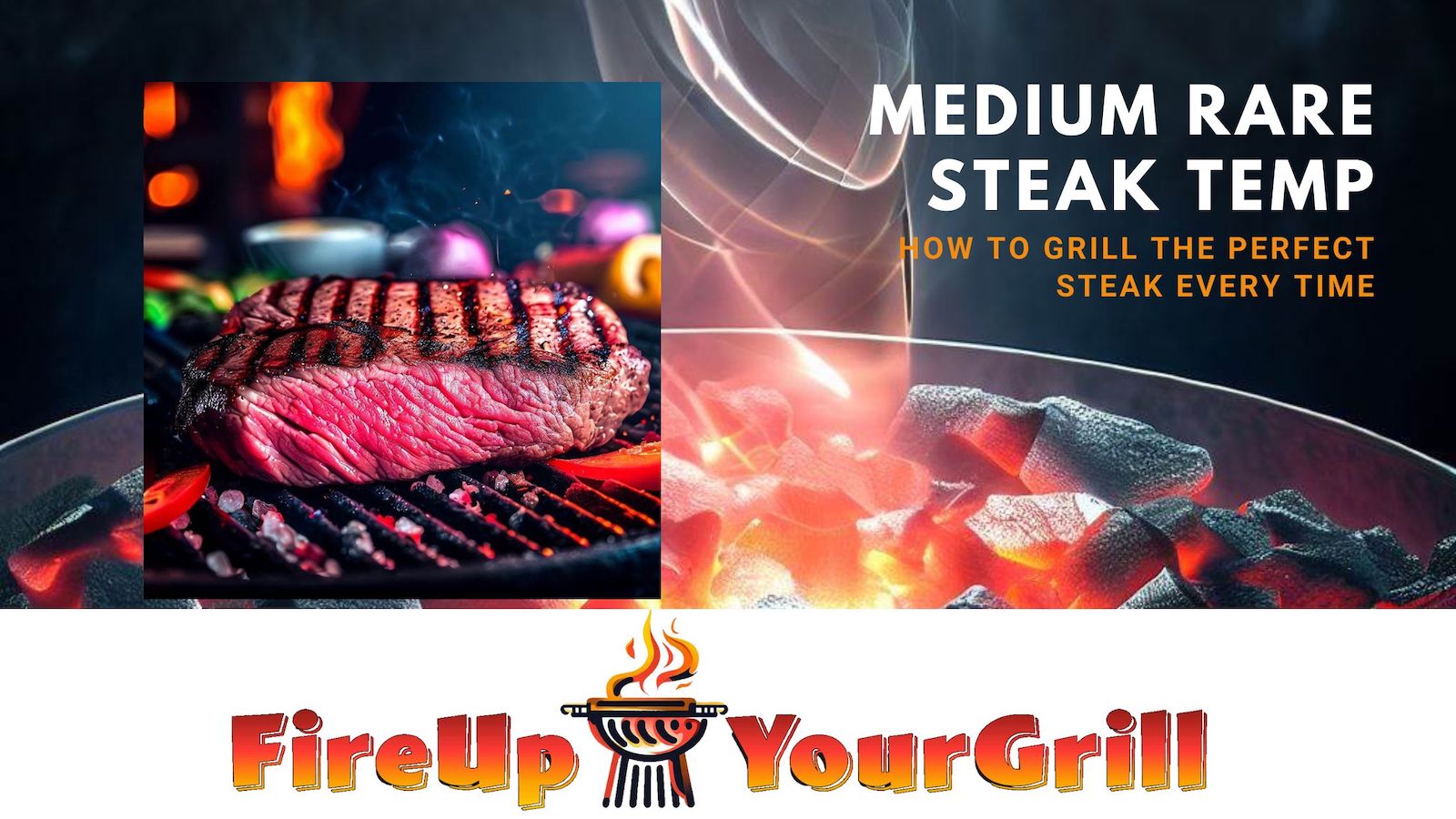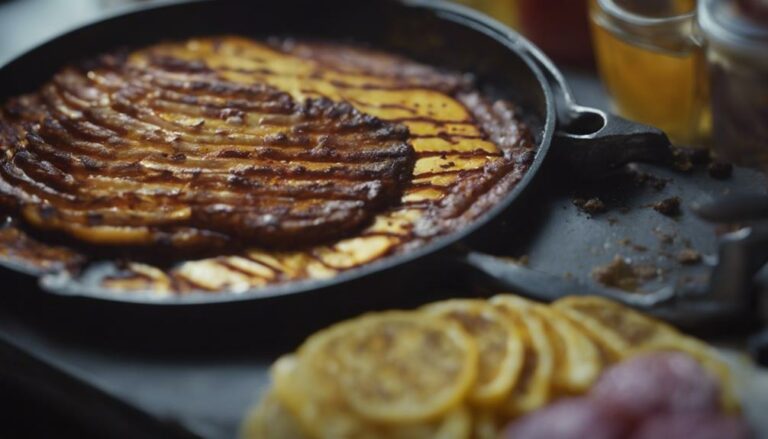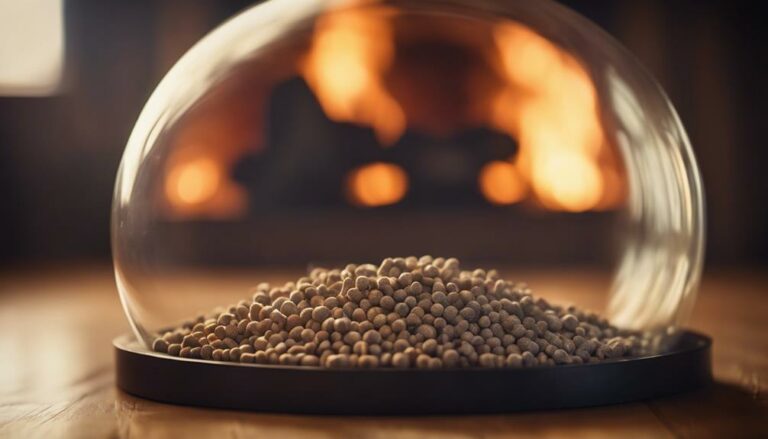If you’re a steak enthusiast, you’re likely familiar with the popularity of medium rare doneness. This delectable level of cooking results in a steak with a pink center, a brown crust, and a tender, juicy texture that tantalizes the taste buds. The Medium Rare Steak Temp is essential for achieving the perfect result. But mastering the art of grilling the perfect medium rare steak consistently requires some know-how. In this article, I’ll share valuable tips and tricks to achieve the ideal medium rare steak, explore its benefits, and present creative serving ideas.
Table of Contents
Understanding Medium Rare Steak Temp
Before delving into grilling techniques, let’s grasp the essence of medium rare steak and its characteristics.
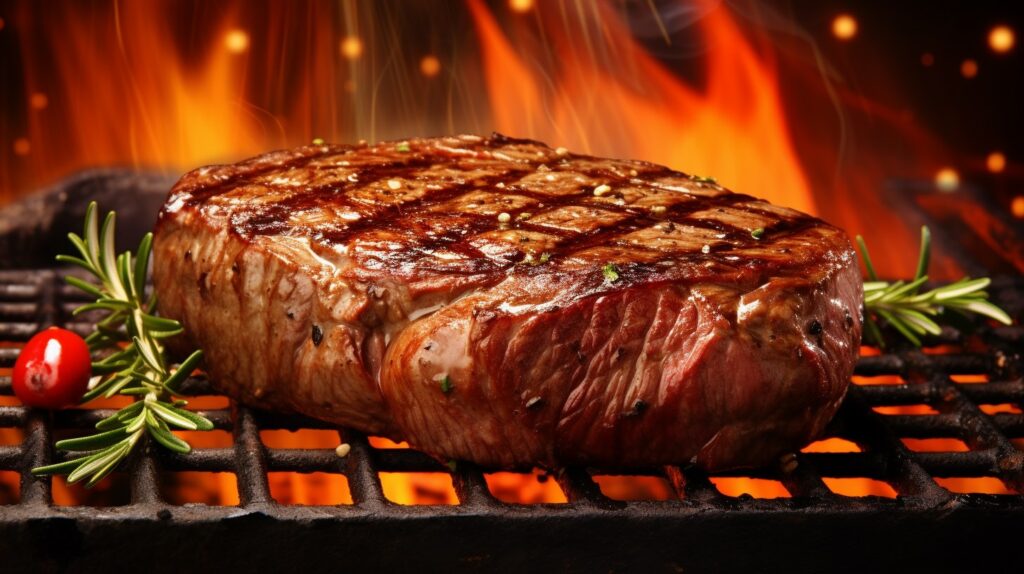
Defining Medium Rare
Medium rare denotes a specific level of steak doneness. It is one of the five common levels, including rare, medium, medium well, and well done. A medium rare steak reaches an internal steak temperature that results in a pink center covering about half the thickness of the meat, surrounded by a brown crust on the outer surface. The texture is tender and juicy, as it retains much of its moisture and collagen.
The Steak Temperature Element
Achieving the perfect medium rare steak temp requires precise steak temperature control. Measure the steak’s temperature using a meat thermometer inserted into its thickest part. The ideal range for medium rare is between 130°F and 135°F (54°C and 57°C). This temperature ensures both food safety and a tender, juicy outcome without overcooking.
The Preference Factor
Medium rare holds a special place among steak lovers due to its balanced flavor, texture, and nutritional qualities. The level of browning and caramelization on the surface contributes to a richer, more complex taste compared to rare or well-done steaks. Its tenderness and moisture in the center provide a delightful eating experience. Additionally, medium rare steaks are relatively lower in fat and cholesterol, offering added nutritional benefits. However, some individuals may find it too raw or have dietary restrictions that limit their consumption.
Benefits of Grilling Steak to Medium Rare
Now that we have a clear understanding of what medium rare steak entails, let’s explore the compelling reasons behind choosing this doneness level when grilling and the delightful advantages it brings.
Enhanced Flavor
Grilling steak to medium rare takes its taste and aroma to new heights. The process creates a delectable brown crust, a result of the Maillard reaction when proteins and sugars in the meat encounter high heat. Hundreds of flavor compounds emerge, contributing to a rich and savory experience. By preserving the natural flavor of the meat, medium rare ensures a culinary delight without the risk of overcooking or losing the essence.
Retained Texture
Preserving the tender and juicy texture of the steak is another compelling reason to grill it to medium rare. This doneness level maintains the pink, succulent center, conserving valuable moisture and collagen. Moisture, responsible for the steak’s juiciness, and collagen, the connective tissue contributing to its tenderness, remain intact. Higher steak temperatures, like in well-done cooking, lead to significant moisture and collagen loss, resulting in dry and tough meat. Medium rare grilling offers a delightful interplay between the crust and the center, creating a more satisfying culinary experience.
Healthful Nutritional Profile
Opting for medium rare grilling ensures that the steak retains its nutritional value and health benefits. The thin, crisp crust formed by grilling contains lesser fat and cholesterol. Fat contributes to flavor and calories, while cholesterol influences blood cholesterol levels and heart health. Rare cooking may accumulate more fat and cholesterol in the crust, leading to less healthful and greasy outcomes. Furthermore, medium rare grilling preserves the pink, fresh center, conserving essential vitamins and minerals. Vitamins play a vital role in supporting bodily functions and overall health, while minerals regulate various physiological processes. In contrast, well-done cooking may result in vitamin and mineral loss, leading to a less nutritious final dish.
Grilling steak to medium rare not only elevates its taste but also ensures a satisfying and healthful dining experience. The balance of flavors, texture, and nutrition makes medium rare a winning choice for steak lovers seeking a delectable and nourishing meal.
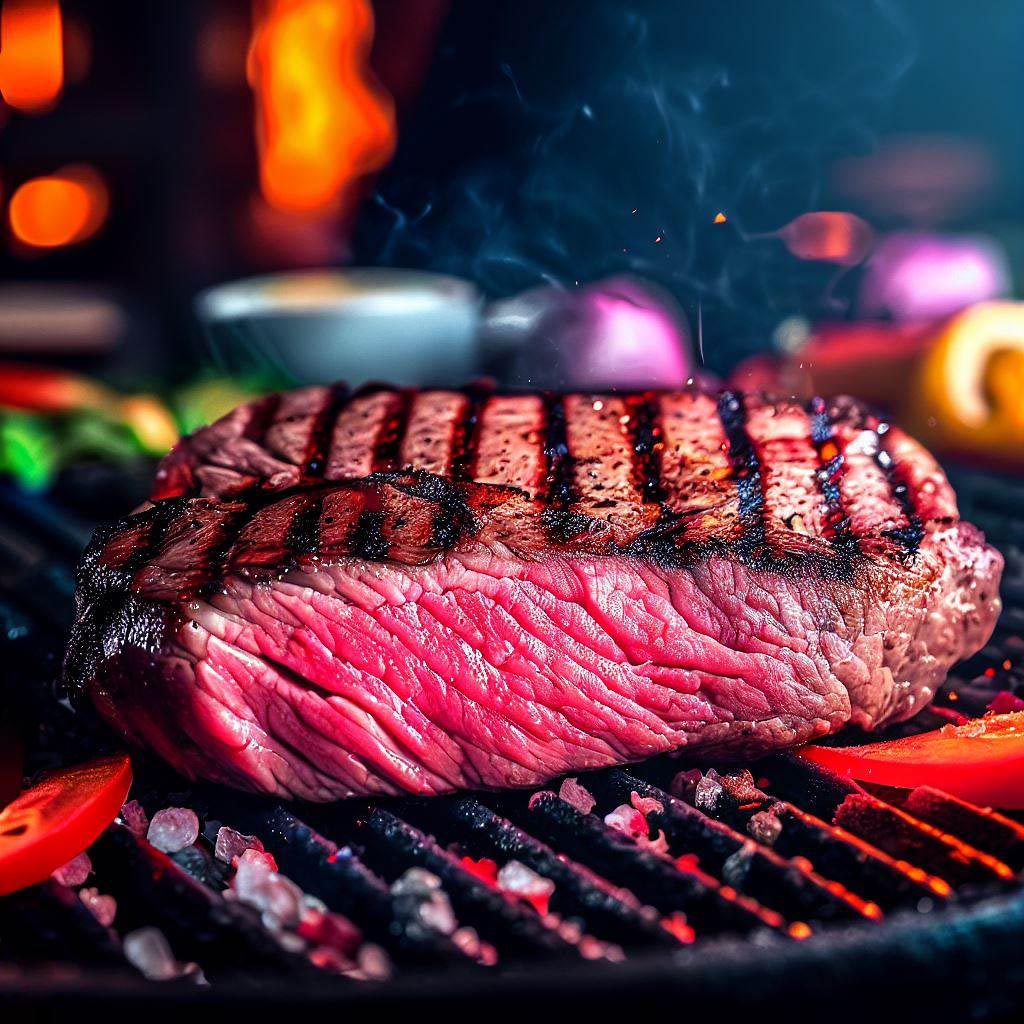
Grilling Steak to Medium Rare: The Steps
Now that we understand the importance of medium rare doneness and its benefits, let’s delve into the step-by-step process of grilling the perfect medium rare steak.
Preparation
Begin by preparing the steak before it hits the grill. This involves choosing the ideal cut, seasoning, and marinating the meat for added flavor.
Selecting the Right Cut
The cut of steak directly influences its taste, texture, size, shape, and cost. Some cuts are more suitable for grilling due to their higher marbling, tenderness, and thickness. Marbling, the intramuscular fat, contributes to flavor and juiciness, while tenderness affects the meat’s chewiness and digestibility. Consider the following grilling-friendly cuts:
- Ribeye: From the rib section, this cut boasts ample marbling and tenderness, offering a rich, buttery flavor and a tender, juicy texture. Its thickness and round shape ensure even grilling.
- Strip: Obtained from the short loin, this cut possesses moderate marbling and tenderness, providing a beefy, savory taste and a firm, chewy texture. Its thin, elongated form allows for quick grilling.
- Filet Mignon: Derived from the tenderloin, this cut may have low marbling but boasts exceptional tenderness. It offers a mild, delicate flavor and a melt-in-your-mouth texture. Its small and thick size makes it perfect for achieving medium rare doneness.
- Sirloin: From the sirloin section, this cut has modest marbling and tenderness. It boasts a lean, meaty flavor and a smooth, lean texture. Its large, thin form allows for versatility in grilling.
Seasoning the Steak
Seasoning a steak involves the addition of salt, pepper, herbs, spices, or other elements to enhance its flavor and aroma. This can be done before, during, or after grilling, depending on personal preference. Various methods of seasoning are available:
- Dry Rub: Create a flavorful crust by rubbing the steak with a blend of dry ingredients, such as salt, pepper, garlic powder, and paprika.
- Wet Marinade: Tenderize the meat and infuse it with flavors and moisture by soaking it in a liquid mixture of ingredients like oil, vinegar, soy sauce, and honey.
- Compound Butter: Add richness and creaminess to the steak by topping it with a mixture of softened butter and herbs or garlic.
Marinating the Steak
Marinating a steak involves allowing it to absorb the flavors and moisture of a marinade before grilling. A marinade typically contains acid, oil, and other seasonings. Proper marinating can enhance the steak’s flavor, texture, juiciness, and tenderness. To make the most of marinating:
Choose the Right Marinade: Select a marinade that complements the steak’s characteristics without overpowering it. Strike a balance with acid for tenderization and oil for coating without excessive greasiness.
Select the Right Container: Use a non-reactive container, such as glass bowls or plastic bags, to hold the steak and marinade without leaks or chemical reactions.
Time It Right: Marinate the steak for 2 to 4 hours in the refrigerator, allowing absorption without affecting color or doneness. Time can vary based on steak type, size, thickness, and marinade temperature. Avoid over-tenderizing or over-cooking the steak.
Grilling with Medium Rare Steak Temp
The next step in grilling the steak to medium rare perfection is to cook it to the desired steak temperature and doneness level. This involves preheating the grill, placing the steak, flipping it, and monitoring the steak temperature.
Preheating the Grill
Before grilling the steak, it’s crucial to preheat the grill to a high temperature. This prepares the grill for optimal cooking and brings several advantages, such as:
- Creating a hot and even cooking surface that sears the steak quickly and evenly.
- Preventing the steak from sticking to the grill or tearing apart when flipped.
- Reducing cooking time, preserving the steak’s juiciness and tenderness.
- Enhancing the steak’s flavor and aroma by creating a charred and smoky crust.
You can achieve the preheating process using various fuel types, such as gas, charcoal, or wood. Additionally, different heat methods, like direct or indirect, can be employed. Direct heat involves placing the steak directly over the flame or coals, providing fast and intense cooking. Indirect heat, on the other hand, places the steak away from the flame or coals, offering slow and gentle cooking. Utilizing hot or cold zones on the grill also plays a role. Hot zones, with more heat, are ideal for searing or browning the steak, while cold zones, with less heat, work well for finishing or resting the meat.
To preheat the grill, adjust the temperature based on your steak’s type, size, and thickness, as well as your personal preference. To achieve the Medium Rare Steak Temp, typically a high temperature of around 450°F (232°C) for direct heat grilling or a medium temperature of about 350°F (177°C) for indirect heat grilling is recommended.
Placing the Steak
Placing the steak on the grill is a crucial step that ensures even and thorough cooking, prevents burning or drying out, and creates an attractive grill mark pattern. Proper placement is essential for achieving the desired results.
To place the steak on the grill, various tools like tongs, spatulas, or forks can be used. Additionally, different methods, such as perpendicular or diagonal placement, offer distinct grill mark patterns.
- Perpendicular Placement: Placing the steak at a 90-degree angle to the grill grates creates a simple and straight grill mark pattern on the steak.
- Diagonal Placement: Placing the steak at a 45-degree angle to the grill grates results in a fancy and diamond grill mark pattern on the steak.
The choice of placement should align with your preferences, the steak’s type, size, and thickness. As a general guideline, for direct heat grilling, place the steak on the hottest part of the grill, while for indirect heat grilling, position it on the cooler section. This ensures proper cooking and optimal flavor.
Flipping the Steak
Flipping the steak is a crucial step in the grilling process, ensuring even and thorough cooking while preventing burning or drying out. It also creates an attractive grill mark pattern on both sides of the steak.
Various tools like tongs, spatulas, or forks can be used to flip the steak effectively. Additionally, different flipping methods, such as once or twice, offer unique results.
- Once Flipping: Flipping the steak only once during grilling results in a more even and consistent doneness level and texture on both sides of the meat.
- Twice Flipping: Flipping the steak twice during grilling creates a more varied and contrasted doneness level and texture on both sides of the steak.
The choice of flipping should align with your preferences and the steak’s type, size, and thickness. As a general guideline, flip the steak once when it easily releases from the grill grates without sticking or tearing. If you desire a well-developed crust and color on one side, flipping twice is recommended. This approach allows for greater control over the final outcome, catering to your personal taste and ensuring a deliciously grilled steak.
Checking for the Medium Rare Steak Temp
Checking the steak temperature is a vital step in ensuring that the steak is cooked to your desired doneness level and readiness for the Medium Rare Steak Temp. It helps prevent undercooking or overcooking, ensuring a safe and enjoyable meal.
Various tools can be used to check the steak temperature, such as meat thermometers, touch tests, or visual cues.
- Meat Thermometers: Using a meat thermometer involves inserting a probe into the thickest part of the steak to measure its internal steak temperature accurately towards the Medium Rare Steak Temp.
- Touch Tests: Touch tests involve comparing the firmness of the steak to different parts of your hand to gauge its doneness level.
- Visual Cues: Visual cues, such as color, juices, or shrinkage, provide signs to indicate the steak’s doneness level.
The checking of the Medium Rare Steak Temp should align with your preferences and the steak’s type, size, and thickness. As a general guideline, check the steak temperature when the meat is nearing its desired doneness, typically after grilling for about 4 to 6 minutes per side for direct heat grilling, or 10 to 15 minutes per side for indirect heat grilling. This ensures that your steak is perfectly cooked and ready to be savored.
Table 1: different levels of doneness for steak, from rare to well done
| Doneness Level | Description | Internal Steak Temperature (Fahrenheit) | Internal Steak Temperature (Celsius) |
|---|---|---|---|
| Rare | Cool red center | 120-125°F | 49-52°C |
| Medium Rare | Warm red center | 130-135°F | 54-57°C |
| Medium | Pink center with some browning | 140-145°F | 60-63°C |
| Medium Well | Slightly pink center with browning | 150-155°F | 66-68°C |
| Well Done | Cooked throughout, little to no pink | 160°F and above | 71°C and above |
Please note that these steak temperatures are just guidelines and can vary depending on the cut and thickness of the steak. It’s always best to use a meat thermometer to ensure accurate doneness.
Resting
Resting the steak is the crucial third step in grilling it to medium rare perfection. This involves removing the steak from the grill, covering it with foil, allowing it to sit, and finally slicing it.
Removing the Steak
The removal of the steak can be done directly or indirectly. Directly involves taking the steak off the grill and placing it on a cutting board or platter without any cover or wrap. Indirectly entails removing the steak from the grill and wrapping it with foil or paper before placing it on a cutting board or platter.
Resting the steak is essential for several reasons:
- It halts the cooking process, preventing the steak from overcooking and preserving its desired doneness level.
- Allowing the steak to rest permits the redistribution of its juices throughout the meat, ensuring maximum juiciness and tenderness.
- Resting makes the steak easier to slice and serve, allowing for an enjoyable dining experience.
The duration for resting the steak can vary based on your preferences, the type of steak, and its size and thickness. As a general guideline, remove the steak from the grill when it reaches your desired temperature (in our case the Medium Rare Steak Temp) and doneness level or when it is about 5°F (3°C) below your target. Resting ensures that your perfectly grilled medium rare steak is ready to be savored and enjoyed.
Covering the Steak
The covering of the steak involves wrapping or covering it with foil or paper immediately after removing it from the grill. This step holds significant importance for several reasons:
- Maintaining Warmth: Covering the steak helps retain its warmth, preventing it from cooling down before serving.
- Creating a Steamy Environment: The covering creates a steamy environment around the steak, aiding in the resting process and ensuring the juices redistribute evenly.
- Preventing Drying Out: By covering the steak, it is protected from drying out or losing its moisture during the crucial resting phase.
You can use different materials such as aluminum foil or butcher paper for covering the steak. Additionally, two methods, loosely or tightly, can be employed.
- Loosely Covering: This method allows for adequate air circulation and steam release, keeping the steak moist without trapping excess moisture.
- Tightly Covering: In this method, the steak is wrapped tightly, minimizing air circulation and steam release, ensuring maximum retention of moisture.
The choice of covering method should align with your preferences and the type, size, and thickness of the steak. As a general guideline, loosely cover the steak with foil or paper after removing it from the grill to optimize the resting process and enhance its succulence.
Letting the Steak Sit
After covering the steak, it should be allowed to sit before slicing. This step can be carried out on a cutting board, a platter, or even in a warm oven. The duration of letting the steak sit can vary depending on the type, size, and thickness of the steak, as well as personal preference.
- Short Sitting Time: For most steaks, a short sitting time of about 5 to 10 minutes is sufficient for resting and finishing the cooking process.
- Long Sitting Time: Thicker or larger steaks may benefit from a longer sitting time of approximately 15 to 20 minutes to ensure proper resting and completion of the cooking process.
The choice of sitting time should align with your preferences and the specific characteristics of the steak. As a general guideline, let your steak sit for about 10% of its total cooking time or until it reaches your desired temperature and doneness level. This ensures that the steak is tender, juicy, and perfectly cooked when it’s time to serve and enjoy the delectable flavors.
Slicing the Steak
Slicing the steak is the final step in the process, involving cutting the steak into thin and even slices after it has been allowed to sit. This step is crucial for several reasons:
- Ease of Eating and Serving: Slicing the steak makes it easier and more enjoyable to eat and serve, creating a satisfying dining experience.
- Revealing Color and Texture: By slicing the steak, its color, texture, and doneness level become evident, adding to the overall appeal of the dish.
- Releasing Flavor and Aroma: Slicing the steak releases its flavorful juices and aroma, enhancing the taste and enjoyment.
To slice the steak, various tools like knives, slicers, or scissors can be used. Additionally, two methods, across or with the grain, offer different outcomes.
- Across the Grain: Slicing the steak perpendicular to the direction of its muscle fibers creates shorter and more tender slices, resulting in a more enjoyable eating experience.
- With the Grain: Slicing the steak parallel to the direction of its muscle fibers creates longer and more chewy slices.
The choice of slicing method should align with your preferences and the specific characteristics of the steak. As a general guideline, use a sharp and thin knife to slice your steak across the grain at a 45-degree angle. This ensures that each slice is tender and flavorful, making your perfectly grilled medium rare steak a delight to savor.
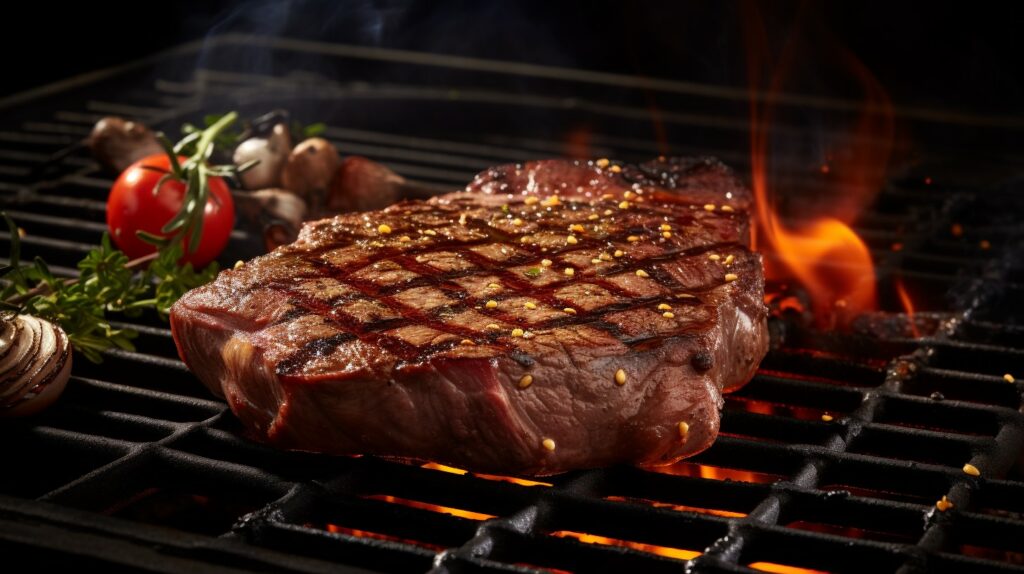
How to Serve Medium Rare Steak?
Now that we’ve mastered grilling steak to medium rare, it’s time to explore the art of serving this succulent dish and discover the best accompaniments, including sides, sauces, and beverages.
Sides
Enhancing the meal, sides play a vital role in complementing the flavor, texture, and overall appeal of medium rare steak. Consider these delightful options:
- Potatoes: A timeless and versatile side, potatoes can be prepared in various delectable ways, such as mashed, baked, roasted, or fried. Their starchiness and creaminess perfectly complement the steak’s taste and texture.
- Salads: For a refreshing and healthy option, salads made with ingredients like lettuce, spinach, kale, tomatoes, cucumbers, and carrots provide a crisp and juicy contrast to the steak.
- Vegetables: Offering a colorful and nutritious addition, vegetables cooked through methods such as steaming, grilling, roasting, or sautéing further enhance the flavor and texture of the steak.
- Bread: To savor every last bit of flavor, bread in the form of rolls, slices, or baguettes serves as a delightful side, absorbing the steak’s juices and adding a touch of softness and chewiness to the meal.
Sauces
Sauces, the liquid or semi-liquid condiments, play a crucial role in elevating the medium rare steak’s experience. These delectable sauces add moisture, flavor, aroma, and color to enhance the overall taste. Consider these delightful sauce options:
- Barbecue: A tangy and smoky delight crafted from ingredients like tomato sauce, vinegar, sugar, molasses, and mustard. Barbecue sauce infuses the steak with sweetness and spiciness, perfectly matching its charred and smoky essence.
- Chimichurri: Embrace the herbaceous and zesty goodness of chimichurri sauce, blending parsley, cilantro, garlic, olive oil, and vinegar. This sauce brings freshness and acidity to the steak, beautifully contrasting its rich and buttery flavors.
- Béarnaise: Indulge in the creamy and luxurious texture of Béarnaise sauce, boasting butter, egg yolks, vinegar, and tarragon. A velvety addition that imparts smoothness and decadence to the steak, harmonizing with its savory and beefy notes.
Drinks
When it comes to complementing the medium rare steak, a selection of beverages awaits to refresh, hydrate, or stimulate the palate. Consider these delightful drink options:
- Wine: Embark on a journey of complexity and sophistication as wine perfectly pairs with the steak’s flavor and texture, elevating the overall dining experience.
- Beer: Embrace the refreshing and lively notes of beer that add a touch of fun to the meal, harmonizing beautifully with the steak’s flavor and texture.
- Water: For a simple yet essential choice, water provides much-needed hydration and balance, cleansing the palate between delectable bites of steak.
- Whiskey: Embark on a tantalizing adventure of rich flavors and aromatic notes with whiskey, as it complements the medium rare steak like no other. The robust and smooth character of whiskey harmonizes splendidly with the steak’s savory taste, creating a truly unforgettable dining experience. Whether you prefer it neat or on the rocks, whiskey is sure to elevate your meal to a whole new level of indulgence.
Conclusion
In conclusion, grilling steak to medium rare offers a delightful and satisfying dining experience. With its pink center, brown crust, and juicy tenderness, medium rare steak tantalizes the taste buds with its rich and flavorful profile. Following the steps of preparation, grilling to the desired steak temperature of the Medium Rare Steak Temp, and allowing the steak to rest ensures a perfectly cooked masterpiece. To complete the feast, pairing medium rare steak with well-chosen sides, delectable sauces, and refreshing drinks elevates the culinary journey. I hope this article has provided you with valuable insights and inspiration for your next grilling adventure. Should you have any queries or feedback, do not hesitate to reach out. Your thoughts are greatly appreciated, and happy grilling!
FAQs
How do I know when my steak is medium rare?
You can use a meat thermometer to check the internal temperature of your steak. The ideal Medium Rare Steak Temp is between 130°F and 135°F (54°C and 57°C). You can also use a touch test to compare the firmness of your steak to the firmness of different parts of your hand. The firmness of medium rare steak is similar to the firmness of the fleshy part of your palm below your thumb when you make a loose fist. You can also use visual cues to look at the color, juices, or shrinkage of your steak. The color of medium rare steak is pink in the center and brown on the edges. The juices of medium rare steak are clear or slightly pink. The shrinkage of medium rare steak is minimal or moderate.
How long should I grill my steak for medium rare?
The grilling time for medium rare steak depends on various factors, such as the type, size, and thickness of your steak, as well as the steak temperature and heat of your grill. Generally, a good rule of thumb is to grill your steak for about 4 to 6 minutes per side for direct heat grilling, or 10 to 15 minutes per side for indirect heat grilling.
How long should I rest my steak after grilling?
The resting time for medium rare steak depends on various factors, such as the type, size, and thickness of your steak, as well as the steak temperature and doneness level of your steak. Generally, a good rule of thumb is to rest your steak for about 10% of its total cooking time, or until it reaches your desired temperature and doneness level.
What are some other doneness levels for steak besides medium rare?
Some other common doneness levels for steak besides medium rare are:
Rare: Rare steak is cooked to a steak temperature of about 120°F (49°C) and has a red center, a brown crust, and a very juicy and soft texture.
Medium: Medium steak is cooked to a steak temperature of about 140°F (60°C) and has a pink center, a brown crust, and a juicy and firm texture.
Medium well: Medium well steak is cooked to a steak temperature of about 150°F (66°C) and has a slightly pink center, a brown crust, and a slightly dry and tough texture.
Well done: Well done steak is cooked to a steak temperature of about 160°F (71°C) or higher and has no pink center, a dark brown crust, and a very dry and tough texture.
What are some other ways to cook steak besides grilling?
Some other common ways to cook steak besides grilling are:
Pan-frying: Pan-frying steak involves cooking it in a skillet over high heat with some oil or butter.
Broiling: Broiling steak involves cooking it in an oven under high heat with some oil or butter.
Roasting: Roasting steak involves cooking it in an oven at low or moderate heat with some oil or butter.
Sous vide: Sous vide steak involves cooking it in a sealed bag in a water bath at a precise steak temperature for a long time.
Further Reads:
The Science Behind Grilling the Perfect Steak – Smithsonian Magazine
https://www.smithsonianmag.com/innovation/science-behind-grilling-perfect-steak-180978054/
This webpage summarizes some of the research findings from meat scientists on how to grill the perfect steak, covering topics such as the choice of meat, the seasoning and marinating of steak, the preheating and grilling of steak, and the resting and slicing of steak. It also explains some of the chemical reactions and processes that occur during grilling, such as the Maillard reaction, the browning and caramelization of steak, and the redistribution of juices.
